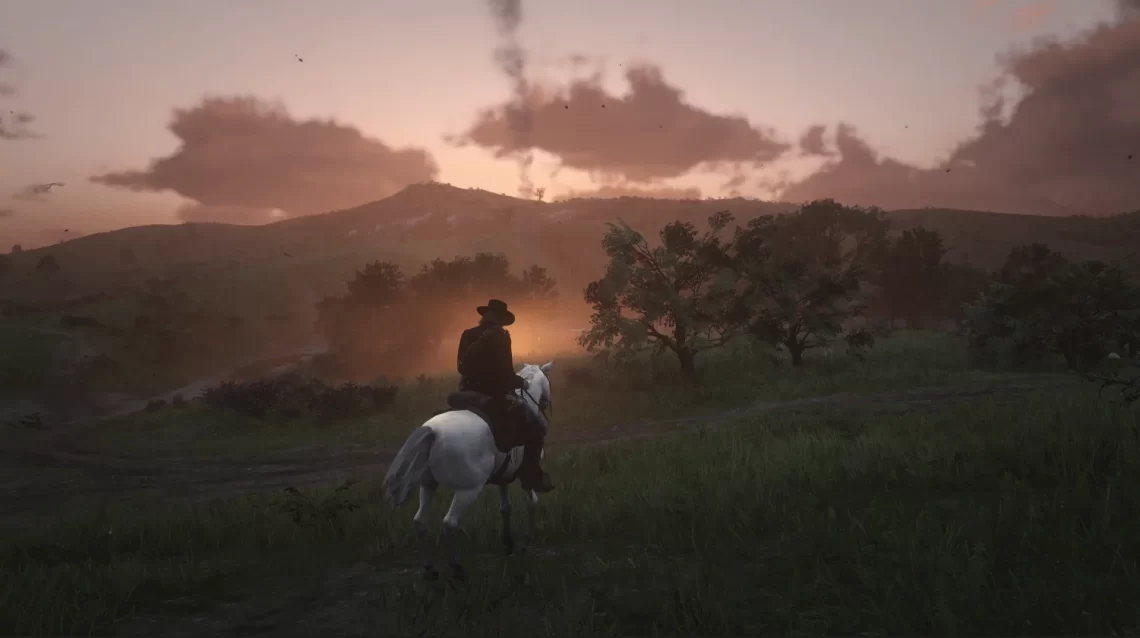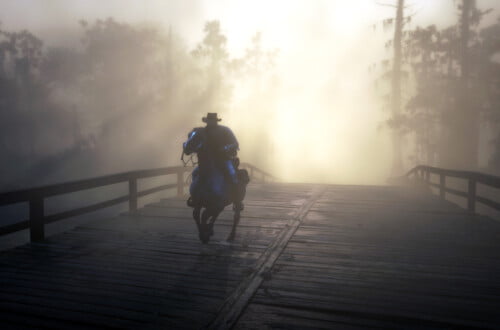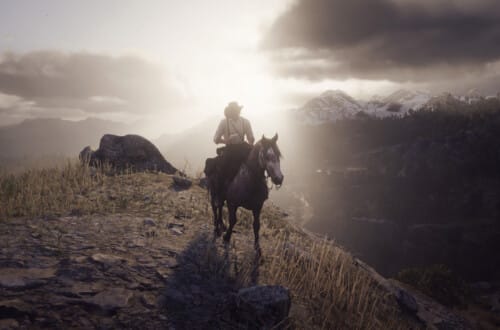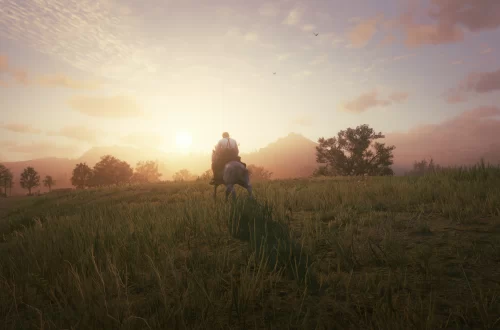The deep impact and faint traces of Cormac McCarthy’s classic Western Blood Meridian on RDR2.
All articles on this site feature detailed discussion of literary allusions in Red Dead Redemption 2, and as such contain unmarked major and minor spoilers for the game, and occasionally the eventual fates of some characters in Red Dead Redemption. Read at your own risk.
The traces of Cormac McCarthy’s Blood Meridian that appear in RDR2 are subtler than Rockstar’s usual bold and underlined references. The novel’s impact on Red Dead Redemption was second only to that of Sam Peckinpah’s The Wild Bunch. In contrast, Blood Meridian makes itself felt throughout RDR2 in the horrific violence, the bleakness, and the bitter irony, but most of the similarities aren’t specific enough to claim them as absolute allusions. A few are certain: the antagonist in Blood Meridian is Judge Holden, who gives his name to the judge who repossesses Jeremiah Compson’s house (“Notice of Repossession”). Bounty targets Tobin Winfield and Tobin Anderson of Red Dead Online are named after Tobin, a character in the novel.
So is Edmund Tobin, whose name appears on a headstone in Pleasance. (It’s never clear, in Blood Meridian, if “Tobin” is the character’s first or last name.) McCarthy’s narrator often calls Tobin “the expriest.” The Edmund Tobin buried in Pleasance has the largest headstone and is buried nearest the church; he may have been the preacher there. When we last see McCarthy’s Tobin, he’s been shot; in Pleasance, Tobin’s headstone specifies that he died of a gunshot wound. But even these allusions to Judge Holden and Tobin are just a touch nebulous: they were (supposedly) historical people, and they appear in My Confession: Recollections of a Rogue by Samuel Chamberlain, a “memoir” that’s mostly false where it isn’t absurdly exaggerated in its details. (Those journalists who like to say we’re living in a “post-truth era” clearly aren’t familiar with the stories that people of the Wild West wrote.)
The most meaningful similarity RDR2 has with the novel is when the Judge tells the protagonist, known only as the Kid, “Dont you know that I’d have loved you like a son?” (ch. 22). If he means it at all, “like a son” means “like someone from whom I expect worship and absolute obedience.” This piece of emotional manipulation is right out of the Dutch Van der Linde playbook.
Other Allusions to Blood Meridian in RDR2

Imagery & Language
Note: Items found in this section are far looser and less certain than the allusions Read Dead usually identifies. It’s only in the aggregate that they’re worth mentioning: other works typically don’t contain so much shared imagery.
- One character wears a “necklace of gold teeth” (ch. 13). Gold teeth are one of the items you can find looting corpses in the game.
- One scene describes a burro turning a mill (ch. 16). A burro turns the cotton mill at Rhodes.
- The Judge is described as a “draftsman” (ch. 11), which is what John calls himself when he tells Charles he’s started drawing (“Bareknuckle Friendships”).
- The novel mentions an iron meteorite (ch. 16), which is one of the Points of Interest in RDR2.
- A description of a ruined church (ch. 2) may have inspired the Abandoned Church.
- The Judge has an inscription on his gun like Micah and Jim “Boy” Calloway do (ch. 10). The inscription is “Et in Arcadia Ego”; one of the Stranger Mission strands is “Arcadia for Amateurs.”
- Two brothers in the novel have the last name Bell. Read Dead has already identified the sources of Micah’s name, but this could be a triple allusion, or a coincidence that worked well for the writers. Micah doesn’t have any striking similarities to either brother.
- A burial ground in the novel sounds similar to the Viking Tomb Point of Interest: “They passed along the ruinous walls of the cemetery where the dead were trestled up in niches and the grounds strewn with bones and skulls and broken pots like some more ancient ossuary” (ch. 13).

Events
- The novel features a conversation with a scalped and dying man, something John may encounter in Tall Trees. That man is a victim of the Skinner Brothers gang; probably the gang was at least partly inspired by the Glanton mercenaries in the novel (who were, unfortunately, real people). Like the Skinners, the mercenaries commit horribly brutal crimes, and are made up mostly of white and Native American members (Delaware, in the novel, but unspecified in the game). For a while, they’re set up at a ferry crossing, robbing and murdering people who need transport over the river. One of the Skinner Brothers ambushes occurs when crossing the Upper Montana River.
- At the climax of the novel, someone is murdered in an outhouse (ch. 23). Of everything in Blood Meridian, this is what RDR2 alludes to most frequently. Dutch tells a story about randomly running across Trelawny in an outhouse (“The New South”). The newspaper article “Lawman Found Dead” describes a cop who was shot and killed in his outhouse. At Micah’s Hideout — site of the game’s final climax — the body of a man is in the outhouse near the lookout tower (credit to the Red Dead Wiki for this information; it never could have occurred to me to look). Finally, the article “Bounties Beware” is about a bounty hunter who killed a criminal who was on the toilet. The bounty hunter is James Langton; “Langton” is an anagram of “Glanton.” (Glanton’s full name was John Joel Glanton.) Glanton was a scalphunter; Langton a bounty hunter — both men, in short, were violent mercenaries.

New essays are published Wednesdays at 1 p.m. E.T./10 a.m. P.T. Follow me on Bluesky, Twitter, or Tumblr for updates.
New here? Visit the Table of Contents to read the essays in order.
Sharing the site is deeply appreciated!
Bibliography
Expand to view sources.
- Chamberlain, Samuel. My Confession: Recollections of a Rogue. Harper & Brothers, 1956.
- Houser, Dan, et al. “Red Dead Redemption II.” Rockstar Games, 2018.
- McCarthy, Cormac. Blood Meridian, or The Evening Redness in the West. 2010 Modern Library Edition, 1985.





